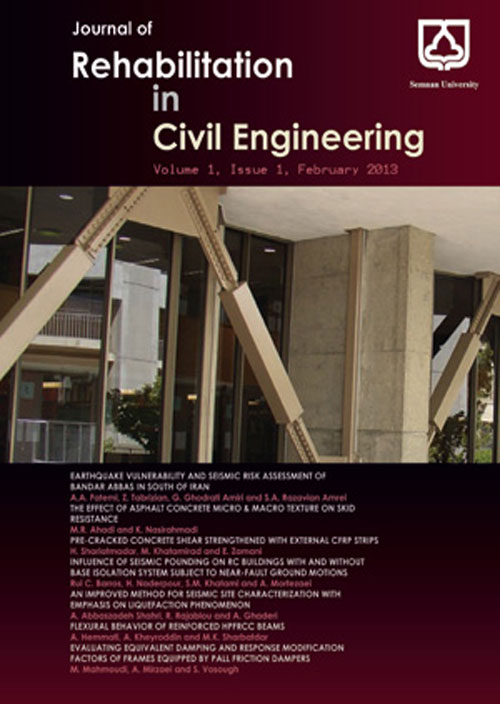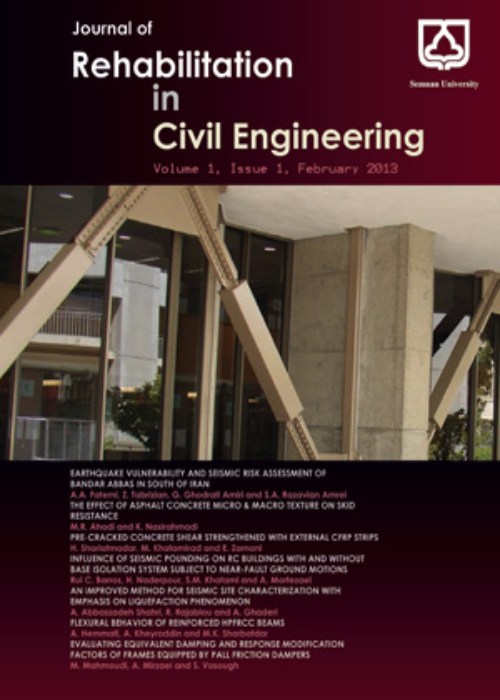فهرست مطالب

Journal of Rehabilitation in Civil Engineering
Volume:9 Issue: 1, Winter 2021
- تاریخ انتشار: 1399/11/25
- تعداد عناوین: 8
-
-
Pages 1-18In recent years, Concrete Filled Tube (CFT) columns have been very much taken into consideration due to the many advantages of the instrument. In experimental studies, the focus has been on compressive loading. Although in many cases the eccentric loading (the presence of a bending moment) has also been investigated, further research is needed in this regard. Therefore, in this study, the steel columns filled with concrete with a regular octagonal cross section were studied under the influence of pressure axial load with eccentricity. The parameters studied in this study include bearing capacity, coefficient of ductility and energy absorption. To test and compare the stated parameters, specimens of 150 cm height, which were filled with plain concrete and fiber reinforced concrete were tested. The compressive axial load has been applied to the specimens by the eccentricity of 50, 100 and 150 mm. The results show that at pure compressive loading, the increase in concrete core capacity increases the load bearing capacity of the specimens so that by increasing the concrete compressive strength by 50%, the bearing capacity of the cross section increases by about 15%. Also, based on the results, the average ductility coefficient for specimens was 7.4, and it seems that this value is independent of the type of loading. The use of concrete with intermediate grade resistance can increase the energy absorbed. However, according to the results, it seems that by increasing the bending moment the positive effects of the concrete core are greatly reduced.Keywords: Load eccentricity, Load–displacement curve, Steel fiber reinforced concrete, Core concrete strength
-
Pages 19-28The aim of this study was to investigate the behaviour of the binders modified by nano-silica and synthesized poly-urethane. To do so, firstly, the binder was modified by three different percentages of nano-silica and poly-urethane. Then, the asphalt binders were aged in different levels based on the test conditions. The high- and low-temperature performance were evaluated using Multiple Stress Creep Recovery (MSCR) and the Bending Beam Rheometer (BBR) tests, respectively. For investigation the fatigue performance in intermediate temperature, Time Sweep (TS) test was performed. The results indicate that the nano-silica improved the performance of the asphalt binder at high temperatures and lowered the efficiency at low temperatures. The synthesized polyurethane had no effect on the high-temperature performance grade of the asphalt binder. However, it improved the low-temperature performance grade. The results of fatigue test indicate that the effect of polyurethane was better than the nano-silica. Fourier transform infrared spectroscopy test was utilized to investigate chemical properties. Obtained results affirmed the presence of nano-silica and polyurethane bonds. Chemical bonds at low and intermediate temperatures, as well as physical properties and stiffness at high temperatures, play a more important role in the performance of the asphalt binder.Keywords: Rutting resistance, Fatigue performance, Nano-silica, Synthesized polyurethane, Fourier transform infrared spectroscopy (FTIR)
-
Pages 29-51In the current study, the effect of the extreme lateral loading on the square and circular Reinforced Concrete (RC) columns with and without retrofitting was investigated. 3D finite element modeling of the columns and impact loading condition was performed using the ABAQUS/Explicit software. The data of a real scale blast test carried out in our previous study were used to verify the modeling accuracy. The effect of secondary moments due to axial load, different geometrical characteristics of the steel jacket, compressive strength of the concrete, and the longitudinal reinforcement on the explosive capacity of the column and its residual axial strength were studied. Results showed that the circular columns perform better under the sudden lateral pressure than equivalent square ones. Also, steel jacketing increased the explosive capacity of the column, which was more effective in the circular columns than the square ones. The results also indicated that steel jacketing with less buckling capacity had the least improvements on the column capacity. It was found that the effects of the initial axial force in the column were significant on its behavior under explosive loading condition, which should be taken into account in any modeling approaches. In general, the P-δ phenomenon had less effect on the circular columns than the square ones. Also, the use of a high-strength concrete and a higher percentage of longitudinal reinforcement further influenced the retrofitted columns than unretrofited (normal) ones, which was more evident in the circular columns in comparison with square columns.Keywords: Impact loading, RC Column, Circular, Square Section, steel jacketing, Residual Axial Load Capacity
-
Pages 52-70One of the common methods to create bond strength in reinforced concrete is providing development length. The bond strength of glass fiber reinforced polymer (GFRP) bar is inherently poor due to its shape, as well as its inadequate mechanical interlocking with concrete. Therefore, providing sufficient development length in this bar is different and more conservative in comparison with steel bars. In this study, three types of concrete are selected, namely normal-weight concrete (NWC), light-weight concrete (LWC), and light-weight fiber reinforced concrete (LFRC). In order to investigate the adequate development length required for GFRP bars and its relation with the concrete type and compressive strength, for Each type of concrete, two different mix designs which have various compressive strengths are considered. 18 cube specimens are fabricated and the direct pull-out test is performed. The results indicate that, in all types of concrete, as the compressive strength increases, the bond strength between concrete and rebar augments. In addition, assessing the bond strength of different types of concrete demonstrates that the use of LWC, due to its inherent weakness of aggregates interlocking, causes pre-mature cracks and loss of the bond strength compared to NWC. Furthermore, LFRC mixtures containing 0.3% and 0.5% macro-synthetic fiber volume fraction reveal that the presence of fibers can be effective in controlling cracks and increases the bond strength between GFRP bars and concrete. As a result, with the increase of the bond strength between the GFRP bar and the concrete, the ultimate capacity of the concrete cross-section augments.Keywords: Reinforced Concrete, Bonding resistance, GFRP Bar, Macro-synthetic fiber, Light-weight concrete
-
Pages 71-83Compacted clay layers are known as one of the common low impermeable layers used in geotechnical structures. Due to geotechnical properties, these layers damaged through cracks in their lifespan. This research has attempted to improve the workability by using self-healing features of clays. By conducting numerous experimental tests, it has been shown that, by increasing the plasticity index of clays, the pace of crack healing process will be enhanced. Experiments have shown that percentages of Montmorillonite Nano Clay (MNC) are quite effective and reduce the flow rate in the samples, which is a sign of self-healing of the cracks by an NC additive. On this basis, NC can be perfectly used to repairing cracks in clayey soils. The results of this study show that in the sample with 1 mm crack, about 500 milliliters of water pass through the crack in 60 minutes under no pressuring conditions. While, if the sample contains 2 and 5 percent NC, the amount of water passing through the cracks within 60 minutes, will be 40 and 5 ml, respectively. This dramatic reduction for passing water reflects the positive effect of Nano sized grains on the closure of the created cracks. Therefore, it can be concluded that the self-healing process occurs earlier in smaller cracks, because the NC and soil particles can easily touch each other after swelling. Five percent of MNC can insure the cracks closure at 100% density. IKeywords: Clay, Cracking, Montmorillonite Nano Clay (MNC), Self-healing
-
Pages 84-101According to the recent Earthquake records, the earthquake duration is longer in some areas, resulting into more structural damage. One of the important factors in reducing earthquake damages is the separation gap between two adjacent structures. This case study investigated the effect of significant duration of the earthquake on two adjacent steel moment-resisting structures with different heights and near to active fault. The pounding between pairs of three 3, 6 and 9-story steel moment frames was evaluated using a nonlinear time history analysis method considering the reduced stiffness and strength. The results showed that for the intended type 3-soil, the risk of pounding and collapse amplification among the 3- and 6-story buildings are higher than others. This is due to the necessity of the Iranian standard 2800 to calculate the separation gap by the nonlinear methods for the buildings with height more than 8 stories. Also, the analysis of the significant duration of the applied earthquakes demonstrated that this parameter is a determining and effective factor in the pounding of structures, especially the adjacent buildings with defferent heights. It is noteworthy all of the analysis was done by 9 earthquake records. This study recommended using the nonlinear method to calculate separation gap while designing two adjacent steel moment-resisting structures with different heights in the near-field area and on the soft soil.Keywords: Significant Duration, Impact of Buildings, Seismic Joint, Near Fault Area
-
Pages 102-113Recently soft computing methods have been employed in most fields, especially in civil engineering, due to its high accuracy to predict the results and process information. Soft computing is the result of new scientific endeavors that make modeling, analysis, and, ultimately, the control of complex systems possible with greater ease and success. The essential methods of soft computing are fuzzy logic, artificial neural networks, and genetic algorithm. In this paper, using 74 valid experimental data, estimation of punching shear capacity of FRP-strengthened RC slabs using two powerful methods (artificial neural network and Group method of data handling) has been investigated. The maximum and minimum dimension of column cross-section, the effective height of slab, the compressive strength of concrete, modulus of elasticity of FRP bar, and the percentage of FRP bars were selected as input variables, and the punching shear capacity of the slab was selected as the output variable. Also, in order to investigate the effect of the variables mentioned above on the results, sensitivity analysis is conducted in both methods. Absolute Fraction of Variance for the two methods showed that the GMDH method had higher precision (1.73%) than the ANN method in the prediction of results.Keywords: Punching shear, RC Slab, FRP, Artificial Neural Network, Group Method of Data Handling
-
Pages 114-138
The current article seeks to investigate the behavior of masonry wall reinforced with timber lumbers and effect of timbers on increasing the shear strength and ductility of wall. To determine the mechanical properties of the timbers, two experiments according to ASTM D143 were performed. All of the mechanical properties required for timber simulation were determined via tensile and compressive tests, and using parametric equations. The behavior of the timbers under tensile force was brittle, and under pressure was semi-ductile. Hill yield criterion was utilized for timber behavior modelling. Predictably, the location of the plastic strain formation in the tensile and compressive specimen was consistent with the location of the fracture in the experimental specimens. In the next parts of the research, the obtained parameters were used to model the mechanical behavior of the timbers. Macro and meso approaches were used for the numerical modeling of the masonry wall. The Willam–Warnke yield criterion was used on the macro scale, and the cohesive-frictional interface constitutive model was utilized on the meso scale. Both numerical models were in good agreement with the laboratory results. However, due to the gap and sliding of the masonry wall in the numerical model, the Meso scale was used in the research. The masonry wall was retrofitted and strengthened by three different patterns of timber placement. An examination of the analysis results showed that by placing the timbers, the wall cracking pattern tends to change, and the ductility and shear capacity of the wall considerably enhances.
Keywords: Timber Properties, Mechanical testing, Masonry Wall, Meso Scale, Constitutive Law


